Abstract
Bike-sharing demand is highly relevant to related problems companies encounter, such as Uber, Lyft, and DoorDash. Predicting demand not only helps businesses prepare for spikes in their services but also improves customer experience by limiting delays
Project Environment
AWS Sagemaker Studio was used for this project as it can be seen in the project repo.
Data set
Data was downloaded from kaggle.
!kaggle competitions download -c bike-sharing-demand
!unzip -o bike-sharing-demand.zip
Problem Statement
Predict Bike Sharing Demand with AutoGluon AutoML
Initial Training
Initial training is used as benchmark for further training to see if there will be changes on model performance. The training is done using Automl. The algorithm used is AutoGluon.
We are predicting count, so it is the label we are setting.
- Ignore casual and registered columns as they are also not present in the test dataset.
- Use the root_mean_squared_error as the metric to use for evaluation.
- Set a time limit of 10 minutes (600 seconds). Use the preset best_quality to focus on creating the best model.
predictor = TabularPredictor(label="count",
eval_metric='root_mean_squared_error',
problem_type='regression',
learner_kwargs={'ignored_columns': ['casual','registered']}
).fit(train_data=train,
time_limit=600,
presets="best_quality"
)
The number of models which were trained were 15, in this stage there was no data preprocessing.
Estimated performance of each model:
model score_val pred_time_val fit_time pred_time_val_marginal fit_time_marginal stack_level can_infer fit_order
0 WeightedEnsemble_L3 -52.847596 11.249226 502.330480 0.001120 0.436674 3 True 15
1 RandomForestMSE_BAG_L2 -53.473435 10.375775 403.099560 0.597212 25.713495 2 True 12
2 ExtraTreesMSE_BAG_L2 -53.810409 10.386975 385.264302 0.608412 7.878237 2 True 14
3 LightGBM_BAG_L2 -55.046580 9.989433 398.853544 0.210870 21.467479 2 True 11
4 CatBoost_BAG_L2 -55.516287 9.831613 446.834595 0.053049 69.448530 2 True 13
5 LightGBMXT_BAG_L2 -60.425971 13.133647 427.012202 3.355083 49.626137 2 True 10
6 KNeighborsDist_BAG_L1 -84.125061 0.038490 0.029288 0.038490 0.029288 1 True 2
7 WeightedEnsemble_L2 -84.125061 0.039427 0.675935 0.000937 0.646647 2 True 9
8 KNeighborsUnif_BAG_L1 -101.546199 0.038787 0.031544 0.038787 0.031544 1 True 1
9 RandomForestMSE_BAG_L1 -116.544294 0.534120 10.116589 0.534120 10.116589 1 True 5
10 ExtraTreesMSE_BAG_L1 -124.588053 0.530154 4.933934 0.530154 4.933934 1 True 7
11 CatBoost_BAG_L1 -130.482869 0.099427 191.457479 0.099427 191.457479 1 True 6
12 LightGBM_BAG_L1 -131.054162 1.488921 25.595079 1.488921 25.595079 1 True 4
13 LightGBMXT_BAG_L1 -131.460909 6.707506 59.929166 6.707506 59.929166 1 True 3
14 NeuralNetFastAI_BAG_L1 -136.015060 0.341158 85.292985 0.341158 85.292985 1 True 8
Number of models trained: 15
Best model was "WeightedEnsemble_L3"
The top ranked model that performed
The best top ranked model in Initial training was “WeightedEnsemble_L3”
ETL
DataFrame.describe() pandas method generates descriptive statistics that summarize the central tendency, dispersion and shape of a dataset’s distribution, excluding NaN values. This method tells us a lot of things about a dataset. One important thing is that the describe() method deals only with numeric values. It doesn’t work with any categorical values. So if there are any categorical values in a column the describe() method will ignore it and display summary for the other columns unless parameter include=“all” is passed.
- count tells us the number of Non-empty rows in a feature.
- mean tells us the mean value of that feature.
- std tells us the Standard Deviation Value of that feature.
- min tells us the minimum value of that feature.
- 25%, 50%, and 75% are the percentile/quartile of each features. This quartile information helps us to detect Outliers.
- max tells us the maximum value of that feature.
The snipet below shows the summary of the describe function and also the information about the dataset
count mean std min 25% 50% 75% max
season 10886.0 2.506614 1.116174 1.00 2.0000 3.000 4.0000 4.0000
holiday 10886.0 0.028569 0.166599 0.00 0.0000 0.000 0.0000 1.0000
workingday 10886.0 0.680875 0.466159 0.00 0.0000 1.000 1.0000 1.0000
weather 10886.0 1.418427 0.633839 1.00 1.0000 1.000 2.0000 4.0000
temp 10886.0 20.230860 7.791590 0.82 13.9400 20.500 26.2400 41.0000
atemp 10886.0 23.655084 8.474601 0.76 16.6650 24.240 31.0600 45.4550
humidity 10886.0 61.886460 19.245033 0.00 47.0000 62.000 77.0000 100.0000
windspeed 10886.0 12.799395 8.164537 0.00 7.0015 12.998 16.9979 56.9969
casual 10886.0 36.021955 49.960477 0.00 4.0000 17.000 49.0000 367.0000
registered 10886.0 155.552177 151.039033 0.00 36.0000 118.000 222.0000 886.0000
count 10886.0 191.574132 181.144454 1.00 42.0000 145.000 284.0000 977.0000
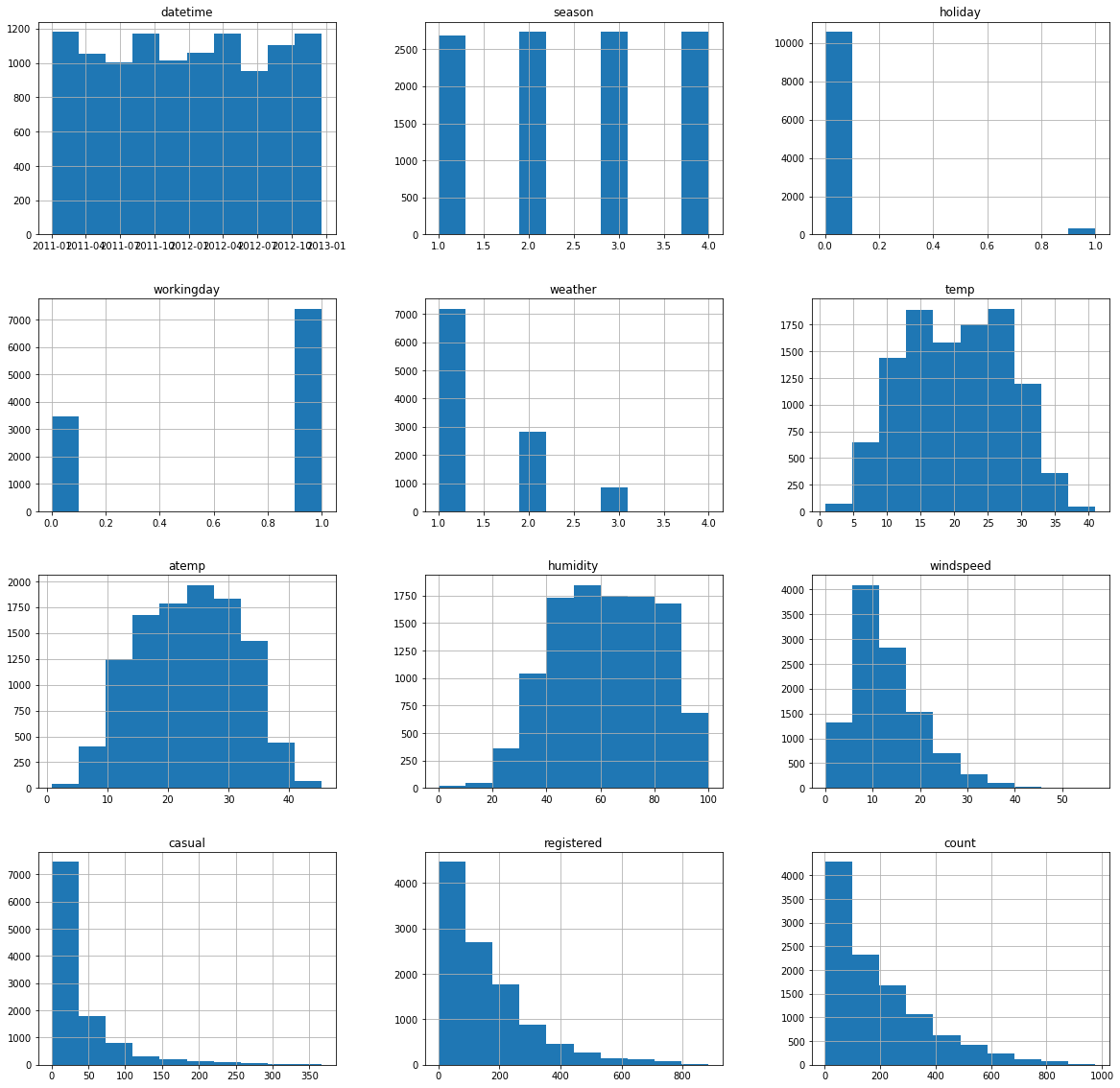
Feature engineering
Transforming the weather and season columns to category from ints since autogluon sees them as ints. Parsing the datetime to separate features for further analyis
Ride distribution for registered and unregistered users
The registered users perform way more rides than casual ones. Furthermore, we can see that the two distributions are skewed to the right, meaning that, for most of the entries in the data, zero or a small number of rides. Finally, every entry in the data has quite a large number of rides (that is, higher than 800).
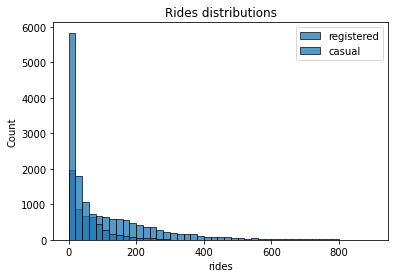
Average of bike using accross the Year
The average of using bikes accross seasons, accross weather, working day and holiday.
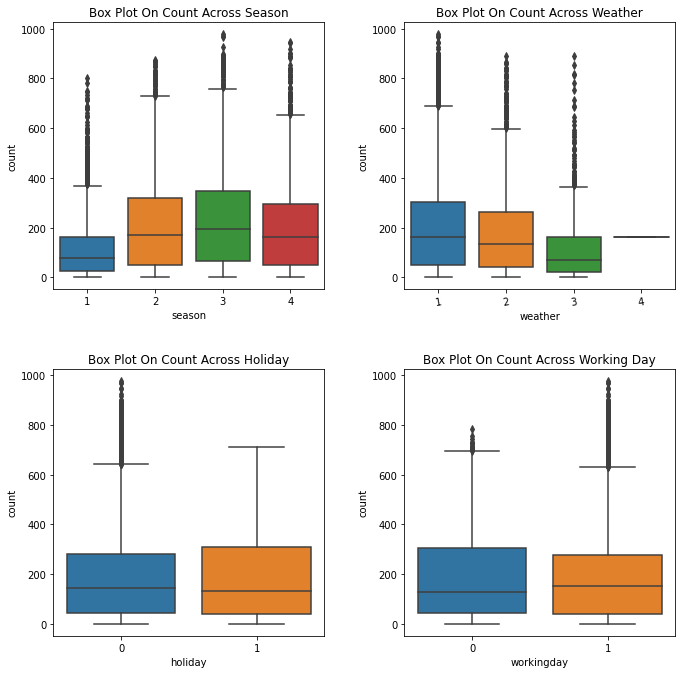
Plotting Correlations
Correlation between rides and temperature . The higher temperatures have a positive impact on the number of rides (the correlation between registered/casual rides and temp is 0.32 and 0.46, respectively, and it’s a similar case for atemp). Note that as the values in the registered column are widely spread with respect to the different values in temp, we have a lower correlation compared to the casual column.
Correlation between rides and temperature
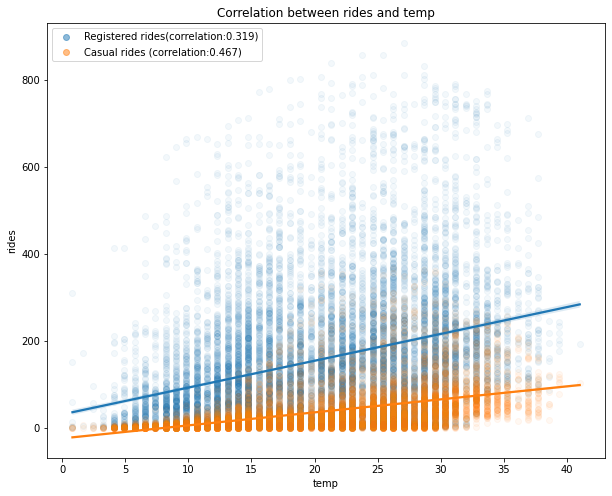
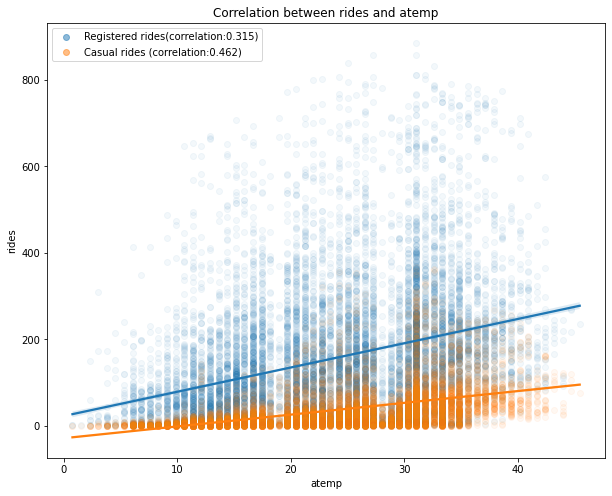
Correlation between rides and humidity
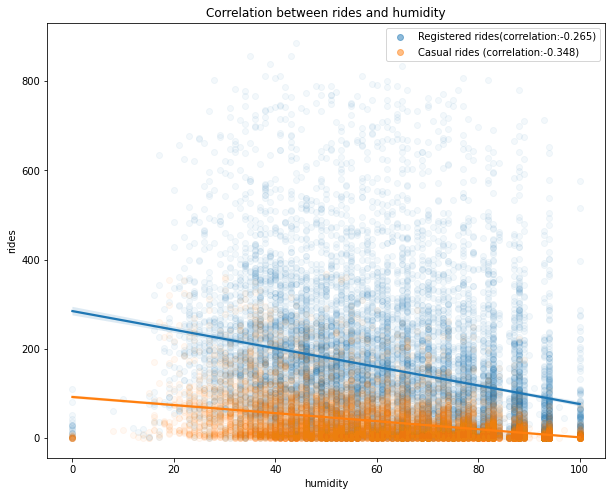
Correlation between the number of rides and the wind speed
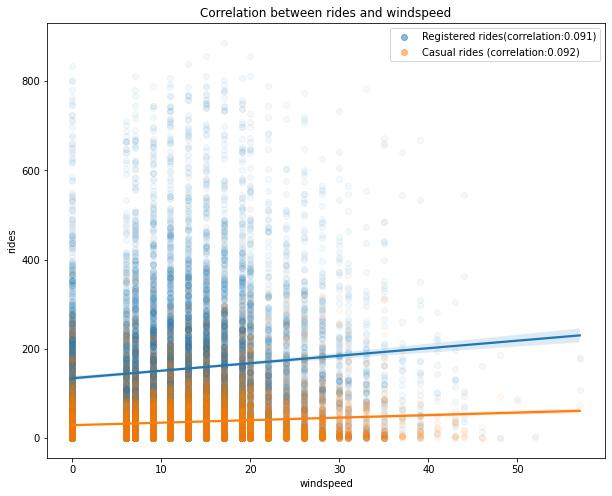
Correlation Matrix Plot
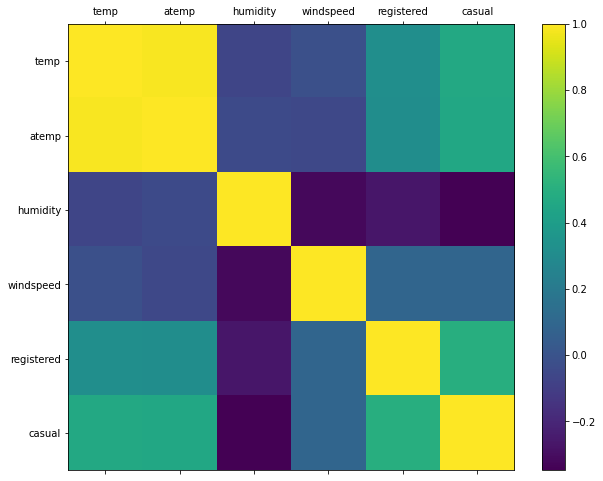
The conclusion of the visualization is that when the temperature is good the hire of the bike is good for both registered users and casual users.
Training After adding additional features
predictor_new_features = TabularPredictor(label="count",
eval_metric='root_mean_squared_error',
problem_type='regression',
learner_kwargs={'ignored_columns': ['casual','registered']}
).fit(train_data=train,
time_limit=600,
presets="best_quality"
)
The model performed better after changing some of the columns/features to categorical data and also after adding new features.
Training Hyper parameter tuning
num_trials = 5
search_strategy = 'auto'
hyperparameters = {
'NN_TORCH': {'num_epochs': 10, 'batch_size': 32},
'GBM': {'num_boost_round': 20}
}
hyperparameter_tune_kwargs = {
'num_trials': num_trials,
'scheduler' : 'local',
'searcher': search_strategy,
}
predictor_new_hpo = TabularPredictor(label="count",
eval_metric='root_mean_squared_error',
problem_type='regression',
learner_kwargs={'ignored_columns': ['casual','registered']}
).fit(train_data=train,
num_bag_folds=5,
num_bag_sets=1,
num_stack_levels=1,
time_limit=600,
presets="best_quality",
hyperparameters=hyperparameters,
hyperparameter_tune_kwargs=hyperparameter_tune_kwargs
)
After hyperparameter tuning, the model slightly changed from the kaggle score of 1.33 to 1.32
A line plot showing the top model score for the three (or more) training runs during the project.
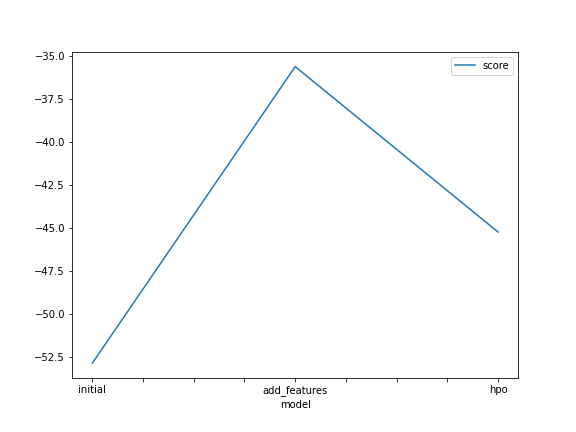
Create a line plot showing the top kaggle score for the three (or more) prediction submissions during the project.
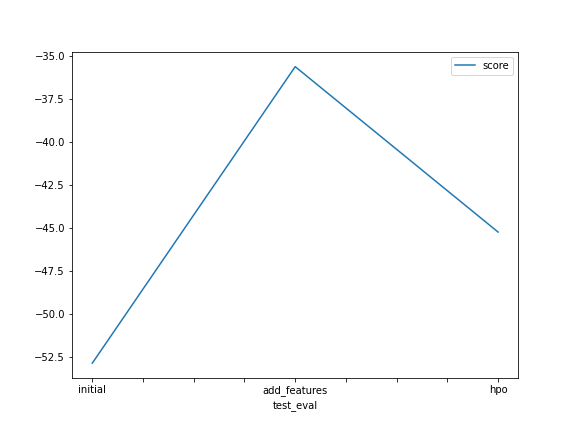
Summary
Estimated performance of each model:
model score_val pred_time_val fit_time pred_time_val_marginal fit_time_marginal stack_level can_infer fit_order
0 WeightedEnsemble_L3 -45.237593 0.001964 136.536450 0.000992 0.555725 3 True 14
1 NeuralNetTorch_BAG_L2/877bc604 -45.947510 0.000861 124.461472 0.000160 32.741020 2 True 13
2 LightGBM_BAG_L2/T5 -49.723478 0.000812 103.239705 0.000111 11.519253 2 True 12
3 WeightedEnsemble_L2 -51.955120 0.001266 46.451789 0.000971 0.569900 2 True 7
4 NeuralNetTorch_BAG_L1/469e5854 -56.261557 0.000171 34.386352 0.000171 34.386352 1 True 6
5 LightGBM_BAG_L2/T2 -61.015430 0.000808 103.493750 0.000107 11.773299 2 True 9
6 LightGBM_BAG_L1/T5 -62.269851 0.000124 11.495537 0.000124 11.495537 1 True 5
7 LightGBM_BAG_L1/T2 -70.588170 0.000097 11.423693 0.000097 11.423693 1 True 2
8 LightGBM_BAG_L2/T3 -77.938179 0.000776 103.443859 0.000075 11.723408 2 True 10
9 LightGBM_BAG_L2/T1 -78.093263 0.000785 103.862269 0.000084 12.141818 2 True 8
10 LightGBM_BAG_L1/T3 -90.207152 0.000110 11.416231 0.000110 11.416231 1 True 3
11 LightGBM_BAG_L1/T1 -95.483677 0.000120 11.565247 0.000120 11.565247 1 True 1
12 LightGBM_BAG_L2/T4 -161.546488 0.000813 103.448732 0.000112 11.728281 2 True 11
13 LightGBM_BAG_L1/T4 -165.490162 0.000080 11.433391 0.000080 11.433391 1 True 4
Number of models trained: 14
Conclusion
- Initial Training
The training time takes is very long compered to when feature engineering was applied There was no data preprocessing in the initial stage of training which is good feature
- New features Training
The score was improved as well as the training time. The new features which were added during feature engineering enhaced the model training fro better results
- Hyperparameter Tuning Training
The time for training was a lot faster compared to the other stages. The number of models for training were 14 compared to 15 with the default parameters.
AutoML frameworks offer an enticing alternative. For the novice, they remove many of the barriers of deploying high performance ML models. For the expert, they offer the potential of implementing best ML practices only once (including strategies for model selection, ensembling, hyperparameter tuning, feature engineering, data preprocessing, data splitting, etc.), and then being able to repeatedly deploy them. This allows experts to scale their knowledge to many problems without the need for frequent manual intervention.
Reflection
Many models are better than few and hyperparemeter tuning enhances learning. There is no train split manually the model does that internally. The model handles missing values and this is the second stage during training
I will spend more time doing the data analysis to get to know data in detail trying different analysis methods.
